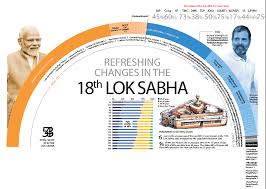Introduction
The 2024 Lok Sabha elections were not just another national vote—they marked a significant shift in India’s political narrative. For the first time in a decade, the Bharatiya Janata Party (BJP) failed to secure a majority on its own. The result? A coalition government under the National Democratic Alliance (NDA), with new power dynamics and deeper regional involvement. So, what does this mean for India moving forward?
🗳️ A Quick Recap of the Results
| Party/Alliance | Seats Won | Majority Mark |
|---|---|---|
| BJP (NDA Leader) | 240 | 272 |
| TDP (Andhra Pradesh) | 16 | |
| JD(U) (Bihar) | 12 | |
| Total NDA Seats | ~293 | ✅ Majority |
| INDIA Bloc (Opposition) | ~230+ | ❌ |
🔍 Key Insight: BJP is still the largest single party, but it needs coalition partners like TDP and JD(U) to remain in power.
⚖️ The Shift: From Dominance to Dependence
Over the past two terms (2014 & 2019), BJP enjoyed full majority rule, allowing for fast legislative action, centralization, and the passage of major bills (like CAA, Article 370 removal, and GST reform). In 2024, the game has changed:
- Coalition Politics is back: Reminiscent of the 1990s era
- Regional parties now have significant leverage in national decision-making
- More negotiation, less bulldozing in Parliament
🧩 What This Means for Key Sectors
1. 🏛️ Governance & Policy
- Expect slower policy rollouts
- Emphasis on consensus-building
- Major reforms (like UCC or privatisation) may be diluted or delayed
2. 📈 Economy
- Coalition partners may push for regional subsidies, special financial packages
- Economic stability likely to continue, but bold reforms may stall
- Investors may tread cautiously until the government’s direction becomes clearer
3. ⚙️ Welfare & Social Schemes
- Increased focus on welfare policies that benefit rural and state-specific voters
- Schemes like PM Kisan, Ujjwala, and Ayushman Bharat may be expanded
4. 🛡️ Defense & Foreign Policy
- Continuity expected as Modi retains global credibility
- Strategic partnerships with US, France, UAE, and Israel likely to strengthen
- However, internal focus might reduce foreign policy activism
🗣️ Voices in the New Coalition
| Party | Likely Role | Influence |
|---|---|---|
| TDP (Chandrababu Naidu) | Infrastructure, IT | High (crucial to majority) |
| JD(U) (Nitish Kumar) | Agriculture, Social Welfare | Medium |
| Shiv Sena (Shinde) | Urban Development | Limited but symbolic |
| Other NDA Allies | Regional Demands | Significant if unity weakens |
📊 Parliament Dynamics
- Rajya Sabha: BJP still has an edge, enabling some legislative action
- Lok Sabha: Close numbers mean debates will be more vibrant, with the opposition blocking controversial bills
- INDIA bloc expected to act as a strong counterweight, with increased unity in floor coordination
📅 Short-Term Priorities for the Government
- Passing the 2025 Union Budget with a focus on jobs, inflation, and farmer relief
- Balancing coalition demands without alienating core voter base
- Handling youth unemployment and inflation, both of which were major election issues
- Reviving industrial growth and making India a global manufacturing hub
🌐 What People Are Saying
- Business Leaders: Cautiously optimistic, but waiting for policy clarity
- Youth & First-Time Voters: Demanding real outcomes over promises
- Middle Class: Focused on job creation, tax relief, and cost of living
- Farmers & Rural Voters: Want action on MSP, loan waivers, and irrigation
🧠 Final Thought
The 2024 Lok Sabha outcome is a reminder of India’s democratic depth. The return of coalition politics is not a weakness—it’s a return to inclusive governance, where states have more say, and policies must reflect diverse aspirations. The success of this government will depend not just on Narendra Modi’s leadership, but on how well allies are managed, empowered, and integrated into the national vision.
































































